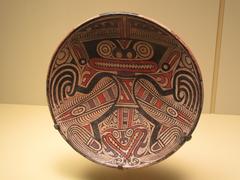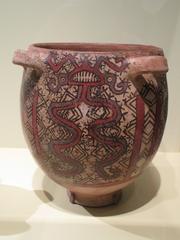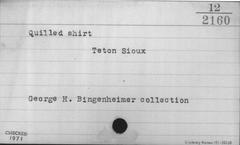
National Museum Of The American Indian George Gustav Heye Center
National Museum of the American Indian George Gustav Heye Center: Visiting Hours, Tickets, and Comprehensive Guide – New York City
Date: 14/06/2025
Introduction: Celebrating Indigenous Heritage in New York City
The National Museum of the American Indian George Gustav Heye Center (GGHC), located in the landmark Alexander Hamilton U.S. Custom House at 1 Bowling Green, Lower Manhattan, is a preeminent destination for exploring Indigenous histories, arts, and cultures across the Americas. Founded upon the extraordinary collection of George Gustav Heye and now part of the Smithsonian Institution, the museum invites visitors to experience over 12,000 years of Native history, from ancient artifacts to contemporary art and cultural expression.
As a hub for education, advocacy, and community engagement, the GGHC not only preserves material culture but also fosters dialogue, celebrates Indigenous creativity, and supports cultural revitalization. Its dynamic exhibitions, interactive activities, and special programming make it an essential stop for history enthusiasts, families, educators, and travelers alike. For up-to-date visiting hours and ticket details, see the official Smithsonian NMAI website.
Table of Contents
- Introduction: Why Visit the George Gustav Heye Center?
- History and Founding
- The Alexander Hamilton U.S. Custom House: Architectural and Cultural Significance
- Collections and Exhibitions
- Advocacy and Repatriation
- Educational and Community Programs
- Visitor Information
- Accessibility and Inclusion
- Special Events and Performances
- Frequently Asked Questions (FAQ)
- Conclusion: Key Takeaways and Planning Your Visit
- References
Why Visit the George Gustav Heye Center?
The GGHC is one of New York City’s premier cultural institutions, known for its unparalleled collection of Indigenous art and artifacts, innovative educational programming, and commitment to showcasing authentic Native voices. Its exhibitions bring to life the histories, traditions, and contemporary identities of Indigenous peoples from across the Western Hemisphere.
Visitors encounter a blend of historic objects, living traditions, and contemporary art, all within the architectural splendor of the Alexander Hamilton U.S. Custom House—a National Historic Landmark (National Park Service). With free admission and year-round programming, the museum is accessible to all and plays a vital role in promoting understanding and respect for Native heritage.
History and Founding
The museum’s origins trace back to the early 20th century, when George Gustav Heye began collecting Native American artifacts. By 1916, he founded the Museum of the American Indian in New York City, amassing one of the most significant collections worldwide (Smithsonian NMAI History). In 1989, the U.S. Congress enacted the National Museum of the American Indian Act, transferring the collection to the Smithsonian and ensuring its preservation and public accessibility (Smithsonian Institution Act). The GGHC officially opened in 1994 within the historic Custom House.
The Alexander Hamilton U.S. Custom House: Setting and Significance
The museum is housed in the Beaux-Arts Alexander Hamilton U.S. Custom House, completed in 1907 and designed by renowned architect Cass Gilbert. The building’s grand architecture, murals by Reginald Marsh, and public spaces create a stunning backdrop for the museum’s exhibitions (National Park Service). Located at Bowling Green, the city’s oldest park, it is easily accessible and close to other notable attractions.
Collections and Exhibitions
Permanent Exhibition: Infinity of Nations
The “Infinity of Nations” exhibition is the centerpiece of the GGHC, displaying more than 700 objects from Indigenous cultures across North, Central, and South America (Infinity of Nations Exhibit). Highlights include:
- Ceremonial regalia and beadwork from the Haudenosaunee (Iroquois)
- Andean feathered tunics and headdresses
- Pacific Northwest Coast carved masks and totemic art
- Contemporary works by living Native artists
The exhibition features multimedia installations and interpretive materials that bring to life the ingenuity, resilience, and creativity of Indigenous peoples (Smithsonian NMAI; WhichMuseum).
Temporary and Rotating Exhibitions
Special galleries host rotating exhibitions developed in partnership with Native communities, artists, and scholars. Recent topics have included:
- Contemporary Native fashion and art
- Indigenous environmental stewardship
- New York’s Native history (“Native New York”) (Smithsonian NMAI)
- The impact of treaties and Native American roles in the city’s development
These exhibitions often feature first-person narratives, interactive elements, and multimedia presentations (TourbyTransit).
Advocacy, Repatriation, and Ethical Stewardship
The GGHC is a leader in ethical stewardship, supporting the repatriation of sacred objects and ancestral remains in accordance with the Native American Graves Protection and Repatriation Act (NAGPRA) (NAGPRA Overview; Smithsonian Repatriation). The museum collaborates with Indigenous communities to ensure respectful representation and supports projects that preserve endangered languages and oral histories.
Educational and Community Programs
imagiNATIONS Activity Center
This interactive space offers hands-on learning about Native innovations in engineering, agriculture, and daily life—ideal for children and families (Uncovering New York). Activities include building igloos, balancing in kayaks, and exploring Native technologies. The center is open primarily on weekends; check the museum website for hours.
Diker Pavilion for Native Arts and Cultures
Hosting performances, lectures, and cultural demonstrations, the Diker Pavilion connects visitors with living Indigenous traditions through music, storytelling, and art (Smithsonian NMAI).
Tours, Lectures, and Special Events
Docent-led tours, workshops, lectures, and film screenings are offered regularly. Events such as the Native Art Market and Children’s Festival highlight contemporary Native voices and community engagement (NMAI Events).
Visitor Information
Visiting Hours and Admission
- Hours: Generally open Tuesday–Sunday, 10:00 AM–5:00 PM. Closed Mondays and major holidays (including Thanksgiving and December 25). Always check the official website for updates.
- Admission: Free for all visitors; no tickets required (NYC.com).
Location and Directions
- Address: 1 Bowling Green, New York, NY 10004 (Uncovering New York)
- Public Transit: Near Bowling Green (4, 5 trains), South Ferry (1 train), and Whitehall Street (R, W trains); multiple bus lines serve the area.
Accessibility
- Wheelchair access: Ramps and elevators throughout; wheelchairs available upon request
- Service animals: Permitted
- Assistive listening devices: Available for programs and tours (Smithsonian NMAI)
- Sign language interpretation: Available for select events with advance notice
Visitor Services
- Information desk: Maps, brochures, and multilingual assistance
- Museum shop: Books, jewelry, textiles, and Native crafts available for purchase (on-site and online)
- Restrooms: Accessible and family-friendly facilities, baby-changing stations
- Cloakroom: Complimentary for coats and small bags; security screening at entrance
Photography and Etiquette
- Photography: Non-flash photography is allowed in most galleries for personal use; some exhibits restrict photography due to cultural sensitivity.
- Visitor etiquette: Please respect the artifacts and maintain a quiet, contemplative atmosphere.
Travel Tips and Nearby Attractions
- Best times to visit: Weekday mornings for fewer crowds; weekends for special programming (but busier).
- Nearby sites: Battery Park (views of Statue of Liberty), Ellis Island Museum (via ferry), Wall Street, South Street Seaport (Uncovering New York).
- Public Wi-Fi: Available throughout the museum.
Accessibility and Inclusion
The GGHC is committed to inclusion, offering:
- Fully accessible exhibitions and facilities
- Assistive listening devices and materials in alternative formats
- Programming and resources for educators, families, and visitors with disabilities
Special Events and Performances
The museum hosts Native dance performances, artist demonstrations, music concerts, and cultural festivals throughout the year. Event schedules are available on the official website.
Frequently Asked Questions (FAQ)
Q: What are the museum hours?
A: Open Tuesday–Sunday, 10:00 AM–5:00 PM; closed Mondays and select holidays.
Q: Is admission free?
A: Yes, admission is always free.
Q: Are guided tours available?
A: Yes, free guided tours are offered; check the museum website or information desk for times.
Q: Is the museum accessible?
A: Yes, GGHC is fully wheelchair accessible, with additional services for visitors with disabilities.
Q: Can I take photos?
A: Non-flash photography is permitted in most areas; look for posted restrictions.
Q: Is there a café or shop?
A: No on-site café, but there is a museum shop and many dining options nearby.
Conclusion: Plan Your Visit
The National Museum of the American Indian George Gustav Heye Center stands as a testament to the resilience, innovation, and ongoing cultural vitality of Indigenous peoples across the Americas. Its world-class collections, immersive exhibitions, and commitment to community partnership make it a cornerstone of New York’s cultural life.
With free admission, comprehensive accessibility, and engaging programming, it welcomes all visitors to deepen their understanding of Native American heritage. Enhance your visit with guided tours, special events, and digital resources like the Audiala app. Stay up to date by following the museum’s official channels and consider exploring related historical sites in New York City to enrich your experience.
References
- Smithsonian NMAI History, 2024, Smithsonian Institution (https://americanindian.si.edu/about/history)
- Smithsonian Institution Act, 1989, U.S. Congress (https://www.congress.gov/bill/101st-congress/house-bill/2668)
- National Park Service, 2024, U.S. Department of the Interior (https://www.nps.gov/places/alexander-hamilton-u-s-custom-house.htm)
- Smithsonian NMAI Collection, 2024, Smithsonian Institution (https://americanindian.si.edu/explore/collections)
- Infinity of Nations Exhibit, 2024, Smithsonian Institution (https://americanindian.si.edu/explore/exhibitions/item?id=953)
- NAGPRA Overview, 2024, National Park Service (https://www.nps.gov/subjects/nagpra/index.htm)
- NMAI Events, 2024, Smithsonian Institution (https://americanindian.si.edu/visit/newyork/events)
- NMAI Online Resources, 2024, Smithsonian Institution (https://americanindian.si.edu/online-resources)
- NYC & Company Tourism Data, 2024, NYC & Company (https://www.nycgo.com/press-and-media/nyc-statistics-page/)
- Smithsonian Repatriation, 2024, Smithsonian Institution (https://www.si.edu/newsdesk/releases/smithsonian-announces-new-policy-ethical-returns-collections)
- American Alliance of Museums, 2021, American Alliance of Museums (https://www.aam-us.org/2021/03/01/celebrating-the-national-museum-of-the-american-indian/)
- WhichMuseum (https://whichmuseum.com/museum/george-gustav-heye-center-new-york-32405)
- Uncovering New York (https://uncoveringnewyork.com/national-museum-of-the-american-indian/)
- TourbyTransit (https://www.tourbytransit.com/newyorkcity/things-to-do/museum_american_indian)
- NY.com (https://www.ny.com/museums/national.museum.of.the.american.indian.html)
- Secret NYC (https://secretnyc.co/national-museum-american-indian-nyc/)
- The Wall Street Experience (https://www.thewallstreetexperience.com/blog/guide-to-the-national-museum-of-the-american-indian-in-nyc/)
- Google Arts & Culture (https://artsandculture.google.com/partner/national-museum-of-the-american-indian)


























































































































































































































































































